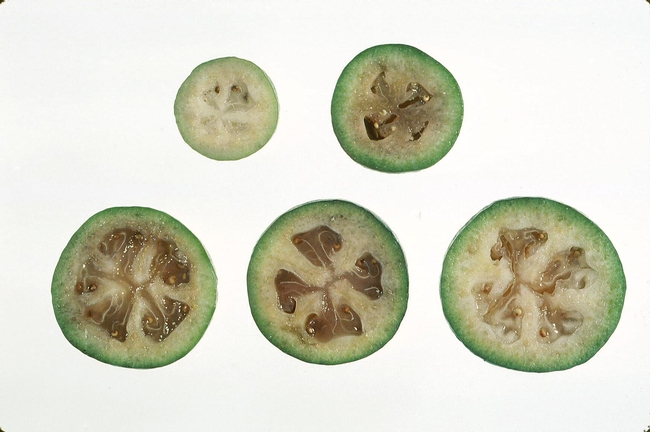Feijoa - You can eat that?
I first tasted a feijoa (fay-zho-uh, or pineapple guava) as a student here at UC Davis many years ago. A friend showed me her secret trees (south side of Wellman in Davis — tons on the ground right now!), and I was hooked. I didn’t think much of it at the time, other than thinking this is one of the best things I have ever eaten in my life. It tastes better than candy, and ripens right around Halloween - sweet! I had never seen or heard of a feijoa. You likely haven’t either, so I’m writing to introduce you.
First a little history. This subtropical plant originated in the higher altitude regions of central South America, but has since been introduced and grown commercially in Europe, California, New Zealand, South Africa and the area around southern Russia. In California, Sutter and Yuba counties were the hot spot for growing pineapple guavas in the late 1980s. Farmers in that area, who benefitted from the kiwi expansion a few years before, enthusiastically jumped into the feijoa business, however did not realize the same success.
According to Adel Kader, UC Cooperative Extension specialist emeritus, "the nurseries that provided the trees were not accurate in identifying the different variety of trees, and there was a large difference in the taste.”
So a farmer had no idea if he had a good tree or not. Additionally, judging fruit maturity is difficult since the fruits do not significantly change color as they ripen and drop to the ground when they’re mature. So the optimal picking strategy is by “touch picking” where if you touch a fruit and, if it comes off the plant, it’s ready to eat. Imagine doing that for a whole orchard.
Back to the present. I rediscovered feijoas after riding my bike down our street before the green waste pick-up a couple years ago and noticed about 30 feijoas in my neighbor’s pick-up pile! They didn’t know you could eat them. So, yes, I picked them out of the pile and introduced my neighbors to the deliciousness of the pineapple guava. And then I promptly went out and bought myself a tree to plant in my own yard.
Feijoas taste like taking the best elements of strawberry, guava and pineapple and mixing them together. They smell pleasantly sweet and flowery. To eat a feijoa, cut (or rip) it in half and scoop out the inside creamy white flesh (a little brownish color is fine to eat). Feijoas are a good source of vitamin C, fiber and potassium, and they even contain a little protein.
So, where can you find feijoas? Well, if you're in Davis, visit the south side of Wellman. Or, you can plant your own tree like I did (you can reference the Postharvest Technology Center’s Produce Fact Sheet for Feijoas here), or you can go to your local farmers market. It’s a short season, so this is the weekend to search them out. When you find them, Kader suggests you “look for a larger fruit with a slight give and a nice aroma.” You won’t be disappointed.
Comments:
Now I have to order a couple different varieties of pineapples guava to plant for next Spring in Seattle Zone 8b US. Thank again for introduction.
Trina Martin
Fresno, CA




Posted by Jeannette E. Warnert on November 8, 2012 at 8:09 AM